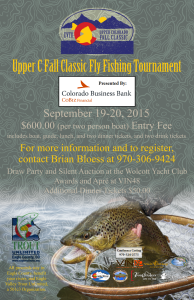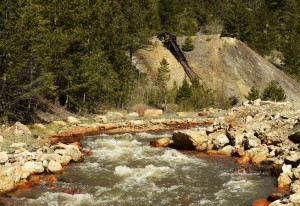Jack Bombardier, an outstanding guide running Confluence Casting working on the Upper Colorado river above Dotsero, wrote the following piece for his friends and clients with his reflections on the Animas spill and the larger context of protecting our headwaters. He was kind enough to grant us permission to reprint his piece. For those who are interested in getting one of the "Headwaters Matter" bumper stickers that he mentions in his piece, we have them available through Colorado TU - email dnickum@tu.org for details.
What Happened To the Animas, or Why Headwaters Matter
A few days ago, after a perfect day on a perfect river (the Colorado) I got home to watch a sickening series of images shown on the nine o’clock news. They were aerial images of the Animas River, looking like a bright orange ribbon of toxicity winding through pastures and past golf courses. The Animas is a river I would have considered just as perfect as my own not long ago. It will be beautiful again one day, but it’ll probably remain tainted for the rest of my lifetime. The Animas begins in the highest of Colorado’s high country, the San Juans, birthplace of five of Colorado’s greatest rivers. The Rio Grande, the Dolores, the Uncompadre, the San Miguel, and the Animas all begin here. There are very few places on earth that are the natal source of so much life, spreading out like spokes in a wheel. The Dolores feeds the Colorado, just before turning its crimson flows towards Moab. The Rio Grande helps water the lower San Luis Valley and is the lifeline of Taos and much of northern New Mexico all the way to Texas and the Gulf Coast. The Uncompadre nurtures one of Colorado’s true breadbaskets, bolstered by an amazing irrigation project built a hundred years ago underneath a mountain using waters from the Gunnison.
And then there’s the Animas. If you grew up back east the way I did, you probably hadn’t heard of the Animas. The Animas has a pretty colorful history, in all meanings of the word. There are plenty of mines above it, and despite the history of men and women doing amazing things at high altitudes in tough conditions, the main legacy of the mining era is its toxic waste. But the Animas feeds into the San Juan, and the San Juan merges into the Colorado at Lake Powell, and the Colorado below that is the lifeline of Phoenix and Las Vegas and the Imperial Valley. The Animas is fed by a little creek called Cement, probably not so named due its bucolic properties. Abandoned mines leach into Cement Creek, which has been fishless for as long as miners have been extracting wealth from these hills. One of these is called Gold King, and it was walked away from by the last men to work it in 1923. Gold King was one of the many holes in the ground trickling nasty stuff into Cement Creek, which in turn flows the Animas. EPA crews were poking around that hornet’s nest of toxicity when something breached and the small trickle turned into a small flood.

The problem with Cement Creek is that it’s a really stupid creek. The water in it wasn’t content enough to just stay where it was, and enjoy the wonderful views it had of the surrounding countryside. No, that deranged Cement Creek water wants to run downhill towards Silverton due that pesky unseen force known as “gravity”. Gravity is something that scientists can explain the effects of and manipulate, but don’t really understand the true cause of. All we really know is, unless external pressure is exerted upon it water runs downhill, and on the western slope of North America, that means that the true connected end point of Cement Creek is the Pacific Ocean, via the Animas, the San Juan, and the Colorado rivers.
The EPA was attempting to mitigate what they knew was an impending problem, and in the process triggered the exact outcome they were hoping to avoid. Whomever was operating that track hoe or bulldozer probably feels badly right now, or if they don’t they should. But the EPA at least had good intentions, and was trying to do the right thing, but we all know what the road to hell is paved with.
The thing that really all brought this to forefront to me was something I heard from a neighbor the day after the news broke. We were having a nice conversation, and admiring how perfect the Colorado River was looking. Knowing that he is also a lover of rivers, I asked him if he’d seen what had happened on the Animas. Since our properties are more than fourteen miles from a cell phone signal, sometimes it’s easy to get a little behind on world events. Turns out, he had. We exchanged a few comments about it, and then he looked at me with a pointing gesture and said, “Do you know that the EPA did it?”
Now my neighbor is a wonderful person, and one of the nicest people I know. But he’s made his career in the uranium mining industry, and I’ve made my livelihood dependent on having a clean river to run. This is one of those things that happen which some people are just going to look at from different perspectives. In strictly technical terms, he was right. The EPA “did” it. If they had just left it alone, and just gone and done something else with its increasingly limited resources, then maybe the Animas River would have kept being one of the most beautiful rivers in America for another year or two, or for the rest of my life, or maybe even longer. But maybe not. The point is, the EPA didn’t create the problem, they were trying to fix someone else’s mess, and that’s not the same thing.
Then my neighbor said, “Well they didn’t break any laws, there were no rules back then”, as if to say, “if it wasn’t illegal then they did nothing wrong”. He was referring to the miners who a hundred years ago had dug the mine, extracted whatever wealth there was to be had from it, and then walked away. That’s a scenario which was repeated thousands of times in the west. There are an estimated 18,000 abandoned mines in Colorado, and 250 of them are leaching toxins into our watersheds. Once again, he was a hundred percent correct. Back then, doing that broke no laws, or least no meaningful ones. But bad behavior back then is why we have laws to try and regulate that kind of behavior now. If the unfettered free market could be allowed to do whatever it wanted and not just walk away from the mess it had created, then we wouldn’t need an EPA in the first place.
The EPA was created in the early seventies, and signed into existence by a radical environmentalist called Richard Nixon. What’s happened on the Animas should be a wake-up call for everyone that protecting watersheds is important, for they make life as we know it possible. I’ve heard one suggestion that this might be a “Cuyahoga River Moment” for watershed awareness, referring to the Ohio River which caught fire in 1969 and was one impetus for passing the Clean Water Act in 1972. I hope something good like that can come from the poisoning of a beautiful river like the Animas. There are those who would defang the EPA in any way possible, up to and including getting rid of it altogether. They might use this horrible but inevitable accident as a rationale to blame or tear down the EPA, which after all exists to help mitigate problems like these and not manufacture them.
Recently, the EPA and the Army Corp of Engineers have moved to restore the protections given to headwaters under the Clean Water Act, (also passed by that Edward Abbey doppelganger Nixon). These logical rules, which understood that little creeks like Cement Creek are connected to rivers below, and not somehow distinct from them, were relaxed under the Bush administration. Trout Unlimited has been calling attention to this issue, and urging its members to contact their congressperson and ask them to not stand in the way of restoring the original language and intent of the Clean Water Act.
The Yakima River TU chapter in Washington State recently printed up a large number of “Headwaters Matter” bumper stickers. They were created in response to some of the issues faced by the Yakima River, including placer mine s. But though the issues in Colorado or anywhere else might not be the same, the message is. Headwaters matter. We all live downriver, and downwind, from someone else. What others do above, has an impact on those below. The higher up a watershed you go, the more lives and ecosystems below are affected by your choices.
s. But though the issues in Colorado or anywhere else might not be the same, the message is. Headwaters matter. We all live downriver, and downwind, from someone else. What others do above, has an impact on those below. The higher up a watershed you go, the more lives and ecosystems below are affected by your choices.
The bottom line is, one of the most verdant and beautiful spots on the planet has been irrevocably harmed, not by someone living and breathing today, but by someone who has long since passed. (Unless you believe in reincarnation, in which smashing the next mosquito you see might help balance the karmic scales). The point is, how do we try to make some good out of something that has virtually no upside to it? Supporting the restoration of headwaters protection by the Clean Water Act is an obvious first step. Another positive thing that might come from this is for people to acknowledge that all of the waters that flow from the highest peak to the widest ocean estuary are all one thing, not separate and distinct. Like an aspen glade consisting of what seems to be individual trees that are actually just one big plant, so too is water from mountain streams all the way down to the sea. Just one thing, and all the same thing. Trying to make one set of rules for the water on your right hand, and another for the water on your left, makes no sense. It is all one water, indivisible by God or whatever deity you are accountable to.
As science explores the universe, and searches deep into the cosmos for worlds suitable for human habitation, one thing becomes abundantly clear. The best possible habitat we’ll ever find in our lifetime or in our grandchildren’s is the humble old rock we’re currently stuck on. Headwaters matter, and so do everything those headwaters are connected to, which is to say, everything else. Headwatters are especially important, because they are upstream of everything we hold dear. If the source becomes fouled, then everything downstream of the source becomes impure, as well. Its our duty as citizens and temporary guardians of this planet to keep the waters we depend on as clean as we can from as high up as we can all the way down to the ocean’s edge.
Watching the toxic orange progression make its way from the highest peaks through Durango, and then on to the southwest desert should really make obvious the connectedness of it all to everyone.
Jack Bombardier













